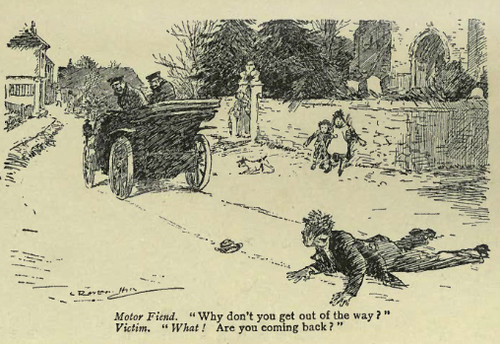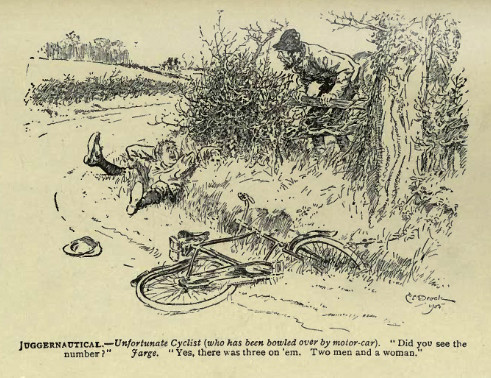Definition of ‘car’, 1907: “an ingenious device for public slaughter”

In its Victorian heyday the satirical magazine Punch (1841-2002) poked fun at bicyclists and automobilists: both were guilty of “scorching” (speeding) and both ignored the prior road rights of pedestrians.
However, by the 1920s, ‘Motor Mania’ had seen to it that the Middle Class had become the Motoring Class, and Mr Punch – ie the writers and cartoonists on the magazine – had become “himself an enthusiast of the whirling wheel.” By the 1940s, cars had killed so many people, J. S. Dean wrote his famous pro-pedestrian tract, Murder Most Foul.
It made little difference. Road deaths had become acceptable to British society.
The rights of the motorist trumped all other rights. This ‘Motor Ascendancy’, before it became the norm, had been mocked by Punch. It’s fascinating to read volumes of Punch and see this transformation: from cars as killers and usurper of rights, motorists as “motor fiends”; to motorists as rightful “owners of the road”, immune to any charges of death on the streets.
There are some illuminating cartoons and poems from the Victorian and Edwardian periods of Punch which show how the coming of the motorcar was feared. “Road hogs”, a term first ascribed to cart drivers and their lumbering vehicles, was switched to describing motorists. A car, to the editor of Punch in 1907, was “an ingenious device for public slaughter”.
This is prescient. Today, if you want to kill with impunity, assassinate your target with a car and you’ll get little more than a slapped wrist. Only an idiot would choose to murder with a gun or a knife.

THE MOTOCRAT (1905)
I am he: goggled and unashamed. Furred also am I, stop-watched and horse-powerful. Millions admit my sway—on both sides of the road. The Plutocrat has money: I have motors. The Democrat has the rates; so have I—two—one for use and one for County Courts. The Autocrat is dead, but I, I increase and multiply. I have taken his place.
I blow my horn and the people scatter. I stand still and everything trembles. I move and kill dogs. I skid and chickens die. I pass swiftly from place to place, and horses bolt in dust storms which cover the land. I make the dust storms. For I am Omnipotent; I make everything. I make dust, I make smell, I make noise. And I go forward, ever forward, and pass through or over almost everything. “Over or Through” is my motto.
The roads were made for me; years ago they were made. Wise rulers saw me coming and made roads. Now that I am come, they go on making roads—making them up. For I break things. Roads I break and Rules of the Road. Statutory limits were made for me. I break them. I break the dull silence of the country. Sometimes I break down, and thousands flock round me, so that I dislocate the traffic. But I am the Traffic.
I am I and She is She – the rest get out of the way. Truly, the hand which rules the motor rocks the world.

MOTOR QUESTIONS (1903)
What rushes through the crowded street
With whirring noise and throbbing beat,
Exhaling odours far from sweet?
The motor-car.
Whose wheels o’er greasy asphalte skim,
Exacting toll of life and limb,
(What is a corpse or so to him)?
The motorist’s.
Who flies before the oily gust
Wafted his way through whirling dust,
And hopes the beastly thing will bust?
The pedestrian.
Who thinks that it is scarcely fair
To have to pay for road repair
While sudden death lies lurking there?
The ratepayer.
Who as the car goes whizzing past
At such law-breaking stands aghast,
(For forty miles an hour is fast)?
The policeman.
Who hears the case with bland surprise,
And over human frailty sighs,
The while he reads between the lies?
The magistrate.

2 thoughts on “Definition of ‘car’, 1907: “an ingenious device for public slaughter””